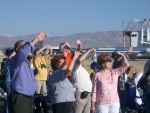June 22, 2004
SpaceShipOne
It was like being back in the 60s. Brian Slesinsky invited me to with him to see SpaceShipOne, the Paul Allen-funded private space program, and we went yesterday for the launch early this morning at the Mojave Airport.
The crowd was a mixture of NASCAR dads there for the tech, aerospace students and sci-fi geeks there to dream, retirees to relive their Cold War youth, and Libertarians to prove that anything the government can do, private industry can do better.
All of them got something from the experience. It was a fascinating mixture of gung-ho American free enterprise optimism (the announcers repeated that the biggest obstacle had not been technical, but convincing the FAA; other times they talked about how this was the start of a new era of California aerospace), nostalgia (Mike Melvill is a space cowboy cast from the classic mold), cool technology and a beer drinkin' good time (though the early-morning liftoff kept most of the beer drinking to the night before).
Political and cultural analysis aside, it was a tremendous event. The technical achievement is huge, and the presentation was organized like clockwork. The rocket's tiny contrail was nearly invisible against the sun. Everyone strained to see it, and when it finally appeared, it was breathtaking in its elegance and fragility (it must have lasted less than a minute). The next 20 minutes was so nervewracking, as everyone tried to catch sight of it, the announcers forgot to do any play-by-play. When it finally appeared, moving a lot faster than I thought any glider should move, chased by 4 planes, it was hard not to feel joy for the pure simplicity of the event, the meaningless act that means so much. I wouldn't have missed it.
7:51AM (see the big image for the contrail): 
I've been noticing the huge amount of coverage in this story yesterday - but you are the first person to point to a new technical achievement - could you explain what is technically advanced about ths launch? It seems mostly a story about economics - we launched something on our own, the private sector but did anything happen that NASA hasn't done MANY times before?
If this was something about a guy in his garage accomplishing what once took a million engineers and so on, that'd be the tech story, I could see that one, but I haven't heard it that way, only that it's privately funded...
I guess this all sounds really dumb-ass, I am very interested in hearing someone else's opinion on this!
Posted by: Steve Portigal at June 22, 2004 07:44 AMI'm not a space scientist, so I won't try to defend the details of their technology, but they did manage to create a wholly original craft design (unlike, say, the Russian Space Shuttle, which looked a whole lot like the American one) using a novel propulsion system (of rubber and nitrous oxide). Then, unlike some guy in a garage, they managed to not just launch it once, but to create a PROGRAM that thoroughly engineered and tested the design to the point that they were confident it was safe to fly with passengers. And they did it with a couple dozen people in the course of 5 years (which is apparently when Rutan first sketched out what the craft would look like), rather than thousands of people that a traditional program would cost.
Ultimately, of these things ARE in the service of economics. They're not the first people to make a vehicle that flies into space. But the economics of what they did point to the fact that there must have been an immense amount of technological innovation in order for them to be able to cost-effectively achieve their goals.
That gets to the heart of the X Prize. The goal of the prize, I feel, is not to put more people into space. Humans have proven that can be done. The real goal is to stimulate innovation by giving people a concrete reason to innovate outside the resources and bureaucracy of a government project. Which is not to say I agree wholly with the Libertarians who were there waving their "Government Bad!" banners, but that government environments are not particularly conducive to radical innovation and it's good that there's an environment for that.
Posted by: Mike at June 22, 2004 10:40 AMHere's a Slashdot post by someone who sounds like he knows his stuff, and he mentions some aspects of what makes this flight technologically unique:
http://slashdot.org/comments.pl?sid=111908&cid=9495736
Posted by: Mike at June 22, 2004 01:31 PM...but yikes did I use a lot of superlatives in that description paragraph! Tremendous, huge, clockwork, breathtaking, nervewracking. The editor in me winces and I apologize for the purple prose but I was and am clearly impressed.
Posted by: Mike at June 22, 2004 08:11 PMThe most important sociological impact of the space program really has been that image of the whole earth. The big blue marble image really changes the way we understand our place.
Space stations and planetary missions will continue to be so complex and vast that only governments can manage them. Every astronaut has reported a shift in their philosphy after looking back at their home planet.
The business model of the Spaceship One investment is space tourism. The real legacy of the x prize may be in the hearts and minds of the captains of industry who will become astronauts.
Posted by: Nesdon at June 23, 2004 12:52 PMThanks for all the non-sneering resonses to a skeptical post. It's sorta becoming rare to have that happen; I appreciate it and I appreciate the insights shared.
Dan Gillmor's column today kind of addresses the same issue. Registration required and it may not be online forever, but the page is http://www.mercurynews.com/mld/mercurynews/business/8990726.htm
Posted by: Steve Portigal at June 24, 2004 12:17 PM






